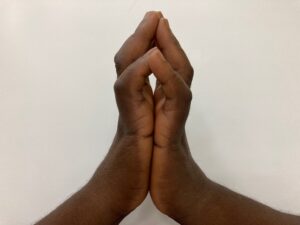The reported prevalence of diabetic cheiroarthropathy varies widely, from 8–53%, depending on the definition used and population studied.5 Diabetic cheiroarthropathy is associated with the duration and severity of diabetes, but can be seen in prediabetes and can be out of proportion to the A1C.5,6
Patients may describe a loss of grip strength, inability to perform fine motor movements and generally impaired hand function. They may also have dysesthesia due to concomitant diabetic polyneuropathy. Contractures mostly occur in the proximal interphalangeal and metacarpophalangeal joints, and tend to progress over time from the fourth and fifth digits radially toward the second and third digits.5
Dr. Bose notes that the diagnosis is primarily clinical, but that “advanced imaging like magnetic resonance imaging (MRI) or ultrasound can help distinguish whether there are changes of inflammatory arthritis or if the presentation is purely mechanical.”

FIGURE 1: The Prayer Sign of Limited Joint Mobility or Diabetic Cheiroarthropathy. A 53 year old woman with a history of type 2 diabetes mellitus of 31 years with associated microvascular complications presented with a 1 year history of gradually worsening, stiffness of the fingers. She reported occasional hand pain with use and impairment of fine movement. Thickened, tight and waxy skin was noted along with fixed flexion contractures of the interphalangeal joints with impaired grip strength and she demonstrated the prayer sign. Strict blood glucose control measures were implemented and physical therapy was recommended.
On clinical examination, patients will be unable to flatten their palms together, known as a positive prayer sign (see Figure 1), or similarly will be unable to place their hand flat on a table.
Unfortunately, there are few therapeutic options for diabetic cheiroarthropathy. Dr. Bose says, “Our limited option is educating the patient on improving diabetic control,” although, it isn’t clear whether improved glycemic control will contribute to meaningful improvements in joint mobility.7
In Dr. Bose’s experience, “flexibility is often quite restricted by the time they present with musculoskeletal manifestations.” Physical and occupational therapy can be tried to improve mobility, but may be of limited benefit.8
“I might see these patients for a few visits to make sure that we aren’t missing something concurrently,” says Dr. Bose. “It can be hard to know right off the bat with mimics, and things can evolve with time. While rheumatoid arthritis and diabetic cheiroarthropathy in the same patient would be rare, it could happen, so one should follow the patient for a year or two to see how they progress.”


